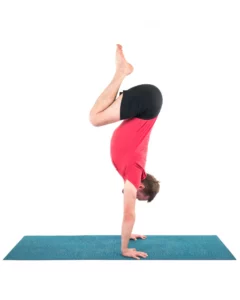Engage Your Shoulders and Abs in Plank Pose

Article At A Glance
The pectoral muscles are not supposed to be major players in Plank Pose (Phalakasana) and Forearm Plank Pose (Ardha Phalakasana). These are both favorite poses of mine. They are both excellent tools for building the core, though I don’t always think they are the right place to start.
When it comes to the core, a deep low belly muscle called the transverse abdominis needs to have a certain amount of tone in isolation before moving into core exercises that require the use of more muscles.
Which Muscles Support Plank Pose? 
There are a lot of muscles involved in the Plank Pose variations. The abdominals of the low trunk all want to be firing as well as the upper trunk muscles—the rhomboids and the serratus anterior in particular. The rhomboids and serratus anterior want to tone the shoulder blades evenly onto the back so the upper chest can broaden. Unfortunately, the pectoral muscles tend to get involved and get in the way.
Muscular balance across the upper back and chest is an elusive thing. Most people are tight in the pectoral muscles at the front of the chest and loose in the rhomboids that connect the shoulder blade to the spine. As a result of this common imbalance, many people rely on the pectoral muscles way too much in the Plank poses.
 Use Your Rhomboids and Abs to Expand Your Chest
Use Your Rhomboids and Abs to Expand Your Chest
Looking across a sea of upper backs in either Plank or Forearm Plank Pose, I hope to see a shallow groove between the shoulder blades that situate the spine slightly lower than the blades. This gully in the upper back indicates an expansion of the upper chest and tone in the rhomboids.
Instead, many students round the upper back slightly, elevating the spine and making the chest more concave. This shortens or engages the pectoral muscles and takes a great deal of work out of the abdominal muscles, which are meant to provide support for the spine.
If you try either of the Plank poses, first feel your tendency in the pose and check out what you do with your upper back and then try softening the upper spine down between the shoulder blades to feel the abdominal muscles really kick in.
How to Practice Plank Pose

There are many ways to approach Plank Pose. Here’s one:
- Start in Downward Facing Dog Pose (Adho Mukha Svanasana) on a yoga mat. Draw your hyoid bone back so that the back of your neck lengthens. Maintain this position throughout.
- Now shift your whole body forward into Plank Pose. Roll your shoulders back so that your shoulder blades slide down and flatten onto your back. Widen your chest and allow your thoracic spine to dip into your back.
- Turn your toes under and lengthen back through your heels, actively keeping your legs lifting up toward the ceiling. Simultaneously lengthen through the top of your head as you stretch your heels back.
- Take a few breaths before coming to rest on the ground or moving into Downward Facing Dog Pose and then to Tabletop Pose (Bharmanasana).
- To practice Forearm Plank Pose, start in Forearm Dog Pose and follow the rest of the instructions. Alternatively, you can start in Sphinx Pose (Ardha Bhujangasana), turn your toes under, and push up into Forearm Plank. Then you can follow all the rest of these instructions.
Also, read...
Warrior I Pose: 5 Strengthening Variations
4 Easy Ways to Use a Sandbag in Yoga Practice
Exercise and Longevity: Diversify Your Yoga Practice for Maximum Benefits
Related courses
Breath as Medicine: Yogic Breathing for Vital Aging
Yoga and Myofascial Release: Releasing Chronic Tension with the Bodymind Ballwork Method
Jonathan FitzGordon has been practicing yoga since 1995 and has been teaching since 2000, having studied with some of the yoga community’s leading teachers. He owned and operated the Yoga Center of Brooklyn from 2001-2009 and created the CoreWalking Program in 2005 because walking is something we all do, and walking correctly is an amazing way to bring positive change to our aging bodies.



